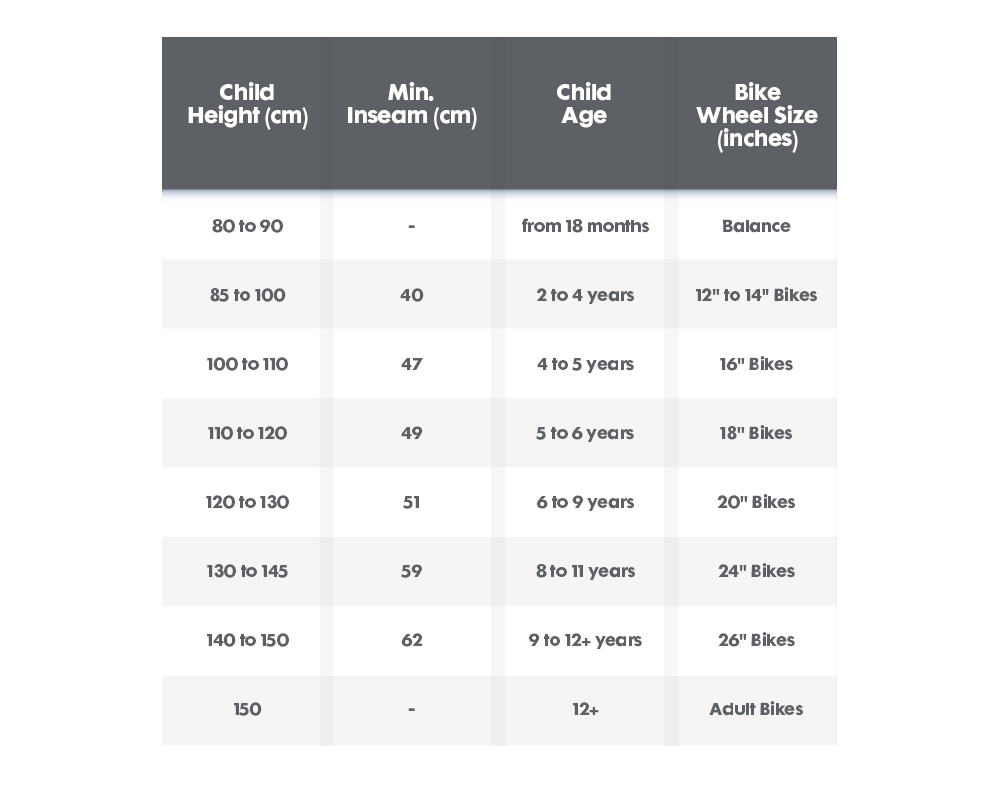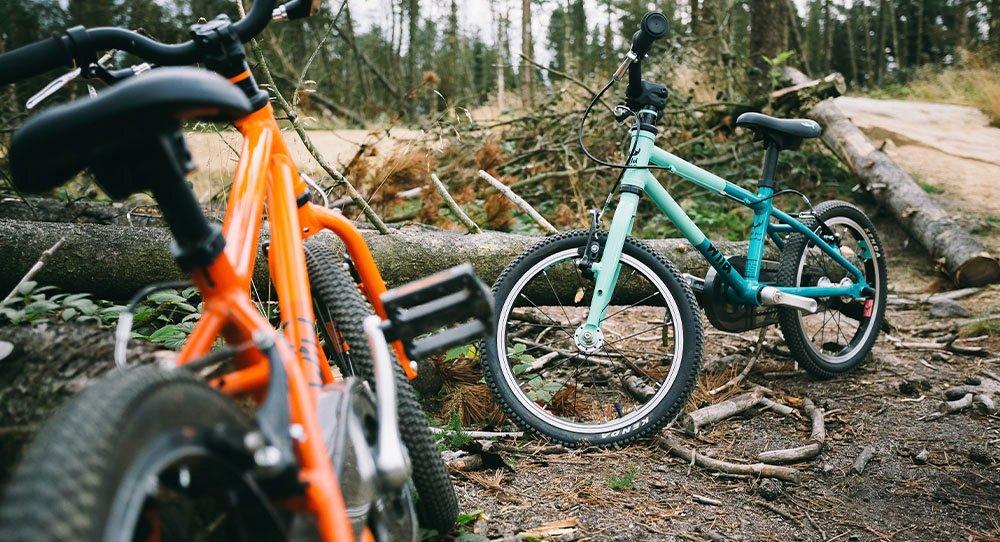0Basket0Item: £0.00
Save £50 on retail prices by being a member
Become a member now or enter your membership number in the basket. More about Membership.
Enjoy your members only prices!
Total items:0
Introducing kids to cycling is a real privilege of parenthood. The joy that children experience when cycling clicks and they're off and away, is priceless. The key to learning cycling quickly and progressing as painlessly as possible is choosing the right bike at the right time. This short guide will provide sound advice to adults buying bicycles for children of all ages.
Forget stabilisers, they are old hat, and they introduce bad cycling habits. Balance Bikes are the bees' knees and the best way to start little ones cycling. These small, pedal-less bicycles allow children to learn the skills of balancing and steering independently of pedalling and braking. Children can progress from a more stable trike to a balance bike from the age of 18 months onwards.
To begin with, a child will keep their feet on the ground. Slowly but surely, they will understand how to steer the bike and will start to experiment with unweighting their feet. As they gain confidence they'll begin to glide. Before you know it, they'll be riding rings around you!
Many balance bikes allow the saddle and handlebar height to be adjusted, some even allow for the wheelbase to be altered. Once they have mastered their balance bike and grown a few inches it will be time to think about their first pedal bike.

By three years old (approximately 85cm tall) a child that has spent 12 months on a balance bike will be ready for pedalling. It's time to find them a pedal bike.
Whereas the size of adult bikes is indicated by frame size, a kid's bike size is determined by its wheel diameter. Kids' bike wheel diameters range from 12 to 24 inches.
Children's bikes begin with 12-inch wheels - for most manufacturers this is the smallest wheel size. Typically, 12-inch bikes are intentionally basic. There are no gears, instead a single, easy-to-pedal gear with a freehub gives a child everything they need to cycle their first tentative metres.
Use the height chart to size your child to a bike. Measuring your child’s inseam will tell you if your child can stand over the top tube of a bike comfortably and reach the pedals when sat on the saddle.
To measure their height, stand the child with their back flat against a wall and measure from the floor to the top of their head. To measure their inseam, place a book between their legs as far up as it will go. Measure from the ground to the top of the book.
Use the chart to select the correct size bike. Alternatively, pop into any Go Outdoors store to try the bikes - excludes GO Express stores which are not large enough to carry our range of bikes.


Until you have some experience with choosing bike, we recommend keeping an eye out for the following features when choosing a child's bike. They are good indicators that a bike has been designed and built by a bicycle manufacturer that understands how to build bikes for children:
Low stand over height
Look for a lower stand over height, meaning the top tube (that's the part of the frame that runs from the top of the seat post to the top of the stem) is lowered to allow a child to step over the frame to mount and dismount more easily.
Alloy frame
Bikes with aluminium alloy frames are typically more expensive than steel frame bicycles. However, they are lighter than steel which makes them easier for a child to manoeuvre and much easier for you to carry… which you inevitably will. A lot!
High volume, grippy tyres
Fatter tyres with plenty of air and a nobly tread will grip better on mixed surfaces and provide some shock absorbency.
Classic Geometry
Many junior bikes have a low saddle and high handlebars to give the child a more upright cycling position like a town bike. This isn't really an optimal riding position for your little one. It raises a child's centre of gravity, unbalancing them, and makes a bike's steering feel twitchy and nervous. A junior bicycle with a classic hybrid/mountain bike geometry, where the handlebars are only slightly higher than the saddle, is what you should be looking for.
Slim cranks
These are more of a nice to have than a necessity. A bicycle's "Q Factor" is the horizontal distance between its two pedals. Children have narrow hips so a bike with a large Q Factor (greater distance between the pedals) requires a child to splay their legs which reduces pedalling efficiency. Slimmer cranks reduce the Q factor making pedalling more efficient and comfortable for a child.
Cockpit room
The area of the bike between the handlebars and saddle is known as the Cockpit. The size of this area is determined by several design criteria and is probably a bit too complex for this article. Suffice to say, the roomier (less cramped) the cockpit the more comfortable and manoeuvrable the bike will feel. Unless the manufacturer has specified a "reach" measurement, the only way to know if the bike's geometry offers enough space in the cockpit is for your child to visit a store and sit on a bike. We can say with confidence that the brands we stock, such as Polygon and Wild Bikes, are designed with optimal cockpit room.
Chain Guard
To prevent your child from getting oily from the chain or catching themselves on the sharp chain ring cog most kids bikes have a chain guard. Other alternatives include bash guards, Chainloopers and belt drive drivetrains, as seen on Early Rider bikes.
Easy-reach brake levers
Children's hands are small and weak when compared to an adult. For a child to be able to brake effectively, the brake levers must be easy to reach for little fingers and require minimal pressure to activate. V-brakes typically require less force to activate than traditional horseshoe-shaped rim brakes and are preferable.
Smaller children can struggle with hand-lever brakes. Often, the combination of tricky coordination, too much reach, and the physical strength needed to pull close a rim brake caliper, make them unsuitable. "Coaster" or back-pedal brakes are uncomplicated and easy to work. It is more common to see coaster brakes in Europe than in the UK, but they are still widespread.
Children grow fast - after a couple of years of good use it is likely time to replace your child's bike with a larger size. The indicators that a bicycle has become too small for you child are:
1. The crank length is too short
your child's knees are too close to the handlebars and he/she struggles to climb the shallowest incline. Their legs whirl around like Roadrunner when travelling at any speed.
2. The saddle is topped out
the saddle is extended to the maximum, but their knees are still too bent when at the bottom of the pedal stroke.
3. A cramped cockpit
Your child is feeling cramped in the bike's "cockpit", sat upright on the saddle with bent arms and knees too close to the handlebars, feeling restricted.
By the age of six, a child's coordination has improved significantly, and they have stronger legs. It's time to extend those cycle rides and introduce some hills. Until this point, a single speed setup worked fine, but gears will open a lot more terrain and range. Shimano's Revoshift (or GripShift once upon a time) makes changing gears simple: With a simple twist of the grip a child can select one of six gears, allowing them to ride up steeper inclines, faster on flats and across loose, uneven trail surfaces.
For keen mountain biking families, six is the perfect age to introduce off-road riding. At a wheel size of 20 inches many manufacturers introduce very capable mountain bikes into their ranges. Quality drivetrains; wide, grippy and shock-absorbing tyres from the likes Maxxis, Schwalbe and WTB; and disc brakes which provide plenty of control – everything your future UCI World Champion could possibly need to start ripping up the trails.
Check out GO's range of great value kids' mountain bikes by Polygon here
Kids bike brands such as Frog and Trek and have popularised the ubiquitous hybrid bike. Half mountain bike, half town bike, they're as suitable for skidding down woodland paths as they are cycling to the local park or delivering the neighbourhood paper round. At GO Outdoors we're pleased to offer hybrid bikes from two fantastic brands: Wild Bikes and Compass.
Wild Bikes build confidence inspiring, lightweight kids' bikes. Their bikes have been designed from the ground up to be tough, lightweight and with parts that are correctly proportioned to make riding effortless and fun. They are adventure-ready bikes built to explore and progress your child’s riding. Available in wheel sizes from 12 to 26 inches with a mix of bright frame colours.
Compass focuses on great quality, easy-to-ride bikes at affordable prices. The brand's range of kids' bikes have steel frames and forgo some of the more expensive componentry found on Wild Bikes. They offer a fantastic starting point for any child beginning their cycling journey.

No matter the age of a child or their cycling proficiency, it is important that they always wear a helmet. Even the smallest accident can have catastrophic implications without a helmet. It's not worth the risk of cycling without one and starting them young is a great way to create a good habit. GO Outdoors stocks a small range of bike helmets for children from popular brands, such as Bell and Giro. Lightweight, comfortable, and good looking, there really isn't a reason for cycling without one.
Read our guide on how to fit a bike helmet properly for a safe and comfortable fit here
By the time your child's stature is approaching 150cm (5ft), it's time for them to ride an adult bike. With adult bikes comes a whole lot more choice. Adult bikes are available with varying wheel sizes (26-inch, 27.5-inch, 29-inch, 650b and 700cc), but it is now the frame size that is used to match a bike to a cyclist.